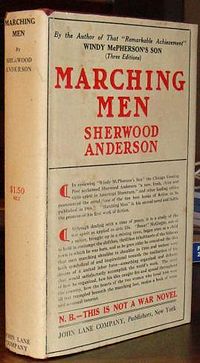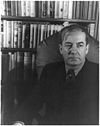- Marching Men
-
Marching Men 
Marching Men first edition coverAuthor(s) Sherwood Anderson Country United States Language English Genre(s) Novel Publisher John Lane Company, New York Publication date September 1917 Media type Print (Hardback) ISBN NA Marching Men is a 1917 novel by American author Sherwood Anderson. It was the second book of Anderson's three-book contract with the publisher John Lane (the first being Windy McPherson's Son (1916) and the third being Mid-American Chants, published in 1918).[1] Marching Men is the story of Norman "Beaut" McGregor, a young man discontented with the powerlessness and lack of personal ambition among the miners of his hometown who comes to Chicago and discovers his purpose to empower workers by having them march in unison.
Marching Men was written as a hobby project while Sherwood Anderson was still working in advertising. It was written several years before he published his first short story and a decade before he became an established writer. A combination of a small first run, mediocre reviews, and poor sales, convinced Anderson's publisher not to give Marching Men a second run. The novel has since been reprinted several times by other publishers including a 1927 Russian translation.
Today, Marching Men is largely forgotten except as a step in the development of its author.
Contents
Development history
Like Windy McPherson's Son, Marching Men was written while the author worked as an advertising copywriter in Elyria, Ohio between 1908 and 1912 (his secretary remembers typing the manuscript on company time "around 1911 or 1912")[2] and was inspired in part by the author's time in Chicago between 1900 and 1906 and while serving in the Spanish-American War.[3]
Plot summary
Books I-II
Born and raised in the miner's town of Coal Creek, Pennsylvania, Norman McGregor (ironically dubbed "Beaut" by his uncle, the "village wit", because of his off-putting appearance), becomes a baker in his teenage years to help support his mother, Nance, after his father's accidental death attempting to save his fellow miners during a fire.
Unsatisfied with his job as a baker and frustrated by the local miners expecting bread on credit and without first settling their debts, Beaut closes the bakery during a miner's strike. That evening, as the now-drink miners move to ransack the bakery (and assault Beaut), he is saved by a troupe of soldiers. The young man is inspired by how the soldiers, marching in formation, scared the disorganized miners into retreat.
When Beaut is a large 18-year-old, his mother becomes ill and the young man, who had been loafing around after closing the bakery, gets a job as a stableman. One day, as a prank, his fellow stablemen insist that Beaut (a teetotaler up to that point) have beer with them, but instead of beer they give him a "horrible mess" that the bartender had concoted at their insistence. After drinking it, Beaut became so drunk that he had to be helped home. On the same evening he leaves Coal Creek for Chicago.
Upon arrival in Chicago just after the 1893 World's Fair, McGregor easily finds work despite a shortage of jobs. Avoiding the city's temptations, he settles into a routine of working during the day and attending night school in the evenings with occasional interruptions to socialize with fellow boardinghouse resident Frank Turner, a barber who makes violins in his spare time. During one of these interruptions, Frank takes McGregor to a dance where despite the big man's aloofness, he meets milliner/shop owner Edith Carson with whom he develops a platonic relationship.
Books III-IV
After the death of Nance McGregor, Beaut returns to Coal Creek to bury her. During the funeral procession, the miners who attend spontaneously fall into step and Beaut is once-again inspired by the power of marching men.
Returning to Chicago, Edith Carson loans McGregor the money necessary for him to quit working full-time and attend school to become a lawyer, his long-time ambition.
Not long after McGregor is admitted to the bar, the son of a wealthy industrialist is found murdered. In order to quell the newspapers, who have been pressuring the underworld by printing revealing stories about it, the political bosses decide to redirect the media's attention by framing and demonizing an acquaintance of McGregor, small-time thief Andy Brown. From jail, Brown requests that McGregor act as his lawyer. Though McGregor refuses at first, he ends up with the job.
After an unsuccessful solo investigation, McGregor turns to wealthy heiress-turned-settlement-house-volunteer, Margaret Ormsby for help. On a tip from Edith Carson, and with Ormsby's connections, McGregor is able to clear Andy Brown of any wrongdoing. In the interim, Margaret Ormsby and McGregor develop a romance.
Books V-VII
While McGregor is slowly building up his idea of marching men, he decides that he wants to marry Margaret Ormsby. As McGregor is leaving a formal party that Margaret's mother, Laura Ormsby, sets up in an attempt to humiliate him (an attempt that fails), McGregor asks Margaret to marry him. But before she can respond, he gets nervous and flees.
A few weeks later, McGregor falls asleep at the house of Edith Carson and wakes up with her stroking his hair. Realizing that their relationship is more intimate then he had thought, he goes to Margaret and reveals his past experiences with women. Margaret hears McGregor's confession and declares that she will marry him, but first, she must go talk to Edith. Not long after the conversation, Edith sells her shop.
On the same day that Edith sells her shop, McGregor's involvement in a teamsters strike inspires him to go there. Finding the shop under new ownership he rushes to the train station. There, he finds Edith about to depart. Together, they go to the Ormsby house and in a confrontation, Margaret cedes her claim over McGregor to Edith. As Edith and McGregor are leaving, McGregor and Margaret's father, the wealthy leader of a plow trust, David Ormsby, shake hands, expressing an honest antagonism towards each other.
Soon, the marching men idea begins to bloom with workers coming together and marching to-and-from work and in the evenings. Becoming nervous over newspaper reports and rumors of the worker gatherings, several "men of affairs" discuss the matter. David Ormsby volunteers to dissuade to McGregor from further organizing but cannot communicate his point to the impassive McGregor.
The marching men movement peaks during a huge march on Labor Day climaxing with a speech by McGregor. Riding in a carriage with her father at the fringe of the demonstration, Margaret Ormsby is overcome by McGregor's oration, but later professes her allegiance to her father. The book ends that same night with a solitary David Ormsby comparing himself to McGregor.
Themes
Literary significance and criticism
Upon publication, reviews of Marching Men were moderate with a small number of reviewers taking strong negative stances. In one such review, an anonymous critic from the New York Times Book Review noted that the beginning of the novel was "sufficiently well done to lead the reader to expect a novel of possibly a trifle more than average interest and average merit"[4] but ultimately concludes that neither McGregor, "nor the book ever seems to get anywhere in particular".[4] Other reviewers too did not hesitate to mention the novel's stunted character development[5][6] and anti-climactic ending.[7] Aside from these faults, several critics also commented on Marching Men's "deliberate vagueness",[8] calling the book a "generous if misty vision of the future".[9]
Despite the book's deficiencies, reviewers were practically unanimous in praising the realistic description and mood of Anderson's settings from Coal Creek[4] to Chicago.[7][5][10] Within these settings, McGregor's scheme was acknowledged by the even-tempered New York Tribune reviewer as a "clever and original idea".[7] Others, like editor Francis Hackett wrote "Where Marching Men succeeds is in thrusting the greater American realities before us..."[11] to which critic George Bernard Donlin, in his Dial review, adds "Mr. Anderson's book interested me chiefly as the expression of a vigorous and sincere mind...".[5]
Written almost a decade before Sherwood Anderson established himself as a writer with the release of his 1919 short story cycle, Winesburg, Ohio, Marching Men is generally considered, along with Windy McPherson's Sons and two other unpublished novels,[12] as one of Anderson's "apprentice novels".[13][14] Viewed in hindsight, the shiftless plot and weak ending of Marching Men can be seen as a precursor to similar criticism in Anderson's later novels.[12]
Publication history
A first edition of 2,500 copies of Marching Men was printed, but poor sales (around 1,000 copies)[1] kept the novel from being reprinted until B.W. Huebsch picked it up in 1921 following Anderson's success with Winesburg, Ohio and novel Poor White. In 1972, the Press of Case Western Reserve University put out a critical edition of Marching Men with an introduction by noted Sherwood Anderson scholar Ray Lewis White which used as its basis Anderson's early manuscripts in addition to the John Lane/B.W. Huebsch version.[15] A Russian edition of Marching Men was published as V Nogu! (loosely translated, "In Step") (Leningrad: Mysl, 1927).[16]
References
- ^ a b White (1972), xv
- ^ White (1972), xiv
- ^ White (1972), xv-xvii
- ^ a b c Anonymous (28 October 1917), 442
- ^ a b c Donlin (1917), 275
- ^ Webb (1917), 1372.
- ^ a b c Anonymous (27 October, 1917), 9
- ^ Anonymous (11 October, 1917), 404
- ^ Boynton (1917), 338
- ^ Hackett (1918), 60-61
- ^ Hackett (1918), 61
- ^ a b Bassett (2006), 26
- ^ Howe (1951), 91
- ^ White (1966), 8
- ^ See White (1972), xvii-xxvii, for an in-depth discussion of White's editorial philosophy
- ^ "V Nogu! (Marching men): roman". Worldcat.org. Accessed 26 September 2011.
Sources
- Anderson, Sherwood (1972). Marching Men. White, Ray Lewis (ed). Cleveland, OH: Case Western Reserve University. ISBN 0-8295-0216-5
- Anonymous "For the People" Nation 105 (11 October 1917): 403-404.
- Anonymous "Marching Men". New York Times Book Review (28 October 1917): 442.
- Anonymous "Dignifying Labor" New York Tribune (27 October 1917): 9.
- Bassett, John Earl (2005). Sherwood Anderson: An American Career. Plainsboro, NJ: Susquehanna UP. ISBN 1-5759-1102-7
- Boynton, H.W. "A Stroll Through the Fair of Fiction". Bookman 46 (November 1917): 337-342.
- Donlin, George Bernard. "Discipline". Dial 63 (27 September 1917): 274-275.
- Hackett, Francis (1918) "To American Workingmen". in Horizons: A Book of Criticism. New York: B. W. Huebsch: 57-61.
- Howe, Irving (1951). Sherwood Anderson. New York: William Sloane Associates.
- Webb, Doris. "Labor in Line". Publishers Weekly 92 (20 October 1917): 1372.
- White, Ray Lewis (1966). "Introduction". in White, Ray Lewis (ed). The Achievement of Sherwood Anderson: Essays in Criticism. Chapel Hill, NC: University of North Carolina. OCLC 276748
- White, Ray Lewis (1972). "Introduction". in White, Ray Lewis (ed). Marching Men. Cleveland, OH: Case Western Reserve University. ISBN 0-8295-0216-5
External links
Scanned text of first edition of Marching Men on Google Books
Works by Sherwood Anderson Novels Marching Men (1917) · Poor White (1920) · Many Marriages (1923) · Dark Laughter (1925)

Short story
collectionsWinesburg, Ohio (1919) · Death in the Woods (1924)
Categories:- 1917 novels
- American novels
- Labor literature
- Novels set in Chicago, Illinois
- Novels by Sherwood Anderson
- Social classes
Wikimedia Foundation. 2010.

